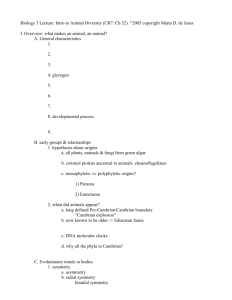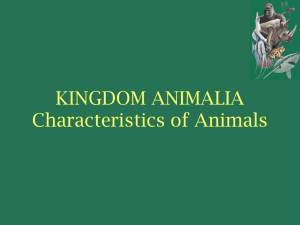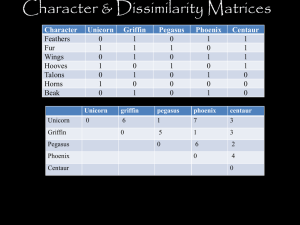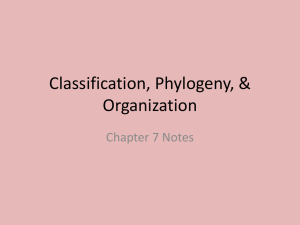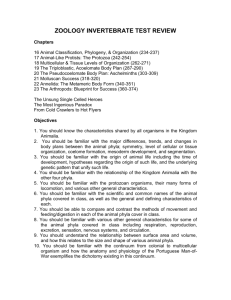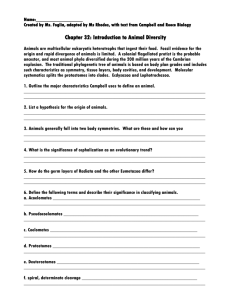Kingdom Animalia - College of the Atlantic
advertisement
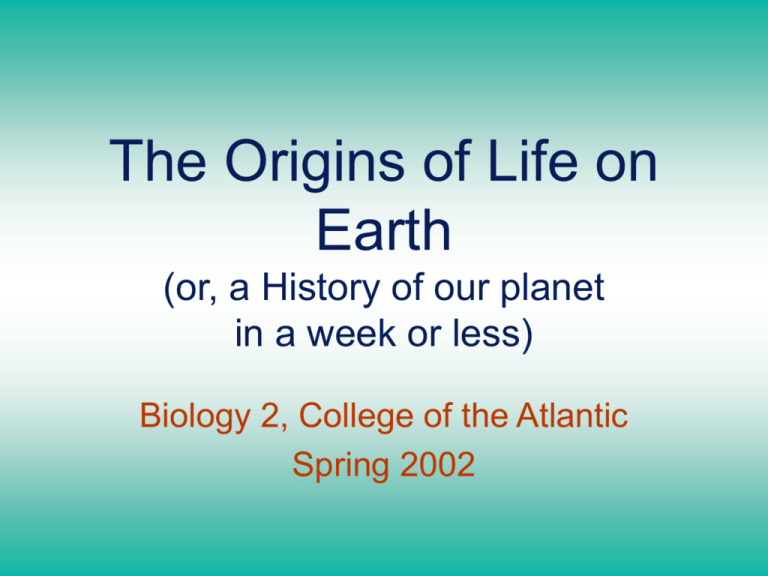
The Origins of Life on Earth (or, a History of our planet in a week or less) Biology 2, College of the Atlantic Spring 2002 • How old is this planet anyway? • Theories of Origin • Geological and Biological timescales • Phylogeny (and an awful lot of it) How old is this planet anyway? • The Universe is probably ~13 billion years old (Big Bang Theory/Doppler Shift) • Earth is ~4.5 billion years old (begins with cooling of crust/solidification) • Earliest records of life ~3.5 billion years ago • First humans (Australopithecus), 0.005 billion years ago • Discovery of Australopithecus fossils , The Fragility of Life - Coincidence #1 • Life can only exist within temperatures corresponding to the boiling and freezing point of water • This range is a fraction of the range between absolute zero (-273°C) and the temperature of the sun (106°C) How did life evolve? • Three theories – Creationism – Extraterrestrial origin (Panspermia) – Spontaneous Origin (Coincidence #2) Physical conditions of early Earth - Coincidence #3 • Temperatures in correct range (in general, water in fluid state, carbon compounds non-brittle) • Size of planet retains an atmosphere • Early atmosphere lacked oxygen, therefore highly reductive • High energy bombardment from sun promotes generation of organics Spontaneous origins of life - 4 steps • Abiotic synthesis and accumulation of organic compounds • Polymerization • Aggregation of polymers into nonliving structures (Protobionts) • Origin of heredity Experimental evidence of Spontaneous Origin • Theories of Oparin and Haldane—tested by Miller and Urey—demonstrate formation of organics under conditions typical of early Earth • Polymerization can occur with appropriate substrate • Abiotically produced proteins (proteinoids) self-assemble into Protobionts (selectively permeable membrane) The final key - Heredity • First passage of genetic information probably occurred through short strands of RNA (also autocatalyst, e.g ribozymes) • Mutations cause variation • “Natural selection” of molecular combinations • Origin of DNA Biological time scales • Biological timescales by necessity follow geological timescales • Often, geological events marked by key biological events (mass extinctions/diversifications) • First fossil record of life 3.5 billion years ago (prokaryote), in the Precambrian • Earliest eukaryote ~1.5 billion years ago (endosymbiotic theory) Earth - The Early Years • Late Precambrian saw the first eukaryotic multicellular life • Boundary between Precambrian and Cambrian (580 mya) marked by a rapid adaptive radiation/diversification of marine life (Cambrian explosion) • By the middle of the Cambrian, all of the animal phyla existing today had evolved The drive behind MacroEvolution • Biological forces: natural selection working in general, but particularly effectively on genes controlling – allometric growth – paedomorphosis • Physical forces – Plate tectonics, leading to formation and splitting of supercontinents The study of evolutionary history: Phylogeny • Modern Darwinian synthesis suggests adaptive radiation from a common ancestor • Concept of phylogeny supported through studies of homology • Traditional classification systems (Linnaeus) are monophyletic, based on homology parallel or divergent evolution • Some groupings are polyphyletic, with analogous structure convergent evolution The Kingdom System • Scientists follow various taxonomic systems: Campbell uses the 5 kingdom classification scheme – Monera – Protista – Plantae – Fungi – Animalia Phylogeny recounts the “natural selection” of species (Earth: the Middle Years) • First major extinction at end of the Paleozoic era (the Permian Extinction), probably caused by collision of tectonic plates to form the supercontinent, Pangaea • Pangaea marks the birth of a new era, the Mesozoic (Triassic, Jurassic, Cretaceous) • Mesozoic ends with second mass extinction— the Cretaceous Extinction (impact hypothesis) And now... • Currently in the Recent epoch of the Quarternary period of the Cenozoic era • History may tell of a third mass extinction? • Radically changing planet will continue to apply selective pressure to species Monera : the Pioneers of Life on Earth • The most ‘successful’ group of organisms on the planet • 3.5 billion year history • Although only 4000 species known, the number of extant species is thought to be ~4,000 – 4 x106 • Found in all ecological niches, including some where other forms of life cannot exist The current importance of Monera • In some cases at base of food chain • Vital roles in various elemental cycles – Carbon cycle – Nitrogen cycle • Interactions with human life – Symbiosis (E.coli) – Pathogenic bacteria (physical, exo/endotoxins) – Commercial/Industrial/Scientific uses The phylogeny of Prokaryotes Early Prokaryote Domain Bacteria (Eubacteria) Domain Archaea (Archaebacteria) Protista Domain Eukarya (Eukaryotes) Fungi Plantae Animalia Archaebacteria • Treated either as Domain, or subphylum • Cell plan similar to most primitive prokaryotic fossils • Tend to exist in extreme environments • Smaller group of species – Methanogens (mmm-mmmm!) – Extreme Halophiles – Extreme Thermophiles (Sulfolobus) Eubacteria • More diverse group – Spirochetes (Treponema) – Clamydias (Clamydia trachomatis) – Gram-positive eubacteria (Bacillus) – Cyanobacteria (blue-green alga) – Proteobacteria (E.coli, Salmonella) Structure • Small (1-5 µm) • Of three general shapes – Coccus (pl. cocci), e.g. Streptococcus – Bacillus (pl. bacilli) e.g. Bacillus – Spirillum (pl. spirilla) e.g. Treponema • Cell wall made of peptidoglycan – Leads to gram +/-ve distinction • Some have a capsule, and/or pili, and/or flagella Physiology • Various forms of nutrition – Autotrophs (obtain carbon from inorganic CO2 • Photoautotrophs (energy from sunlight) • Chemoautotrophs (energy from inorganics) – Heterotrophs (carbon from organics) • Photoheterotrophs • Chemoheterotrophs** • Origins of glycolysis, chemiosmosis and cellular respiration Reproduction • • • • Single strand of DNA No mitosis/meiosis Only Binary fission Some sexual recombination through – Transformation – Conjugation – Transduction • Some form endospores Kingdom Animalia Invertebrata • • • • What is an animal? Anatomy, Embryology and Ontogeny Parazoa Eumetazoa – Radiata/Bilateria – Acoelomate/Pseudocoelomate/Eucoelomate – Protostomes/Deuterostomes What is an animal? • Likely ancestor is a protist: a Precambrian choanoflagellate • Multicellular, heterotrophic eukaryotes (usually exhibit ingestion) • Storage of energy-rich reserves as glycogen • Lack of cell walls. Unique cell junctions • Unique tissues: muscle, nervous tissue • Unique embryology Embryology • Diploid zygote divides by the mitotic process of cleavage • Formation of blastula followed by gastrulation (creation of gastrula) • Mode of embryological development provides a taxonomic key to invertebrates First taxonomic dichotomy • Asymmetry versus Symmetry divides Kingdom Animalia into sub-kingdoms: – Parazoa (lacks tissues, asymmetrical, “like animals”). Represented by only one phylum: Porifera (sponges) – Eumetazoa (“true animals”, exhibit symmetry, represented by remainder of Kingdom Animalia Porifera (Sponges) • General form: Two layered cup (separated by mesohyl), with porocytes entering into spongocoel, exiting through osculum • Outer layer (epidermis) reinforced by spicules (Si) • Filter feeding by Choanocytes that line endodermis • Transport of materials by Amoebocytes Second taxonomic dichotomy • Radial versus bilateral symmetry – Super-phylum Radiata exhibits radial symmetry. Two phyla include: • Cnidaria (jellyfish, anemones, corals and hydra) • Ctenophora (combjellies) – Super-phylum Bilateria exhibits bilateral symmetry (rest of invertebrata) Bilateral symmetry leads to... Cephalization • Bilateral symmetry implies a directionality to the animal • With movement in a specific direction comes development of sensory equipment at end that encounters environment first • Collection of sensory nervous tissue at anterior end of animal = cephalization • Type of symmetry also reflected by embryonic germ layers seen in blastula/gastrula: Ectoderm Mesoderm Endoderm Diploblastic = Radiata (endoderm/ectoderm) Triploblastic = Bilateria (endoderm/mesoderm /ectoderm) Cnidaria (Jellyfish, etc.) • Diploblastic, radially symmetrical (i.e. no cephalization) • Phylum characterized by cnidocytes that eject nematocysts • Gastrovascular cavity (GVC), with one opening (mouth/anus simultaneously) • Tentacles to pull prey into GVC • Some species exhibit alternation of sexual and asexual forms (e.g. Obelia) • Classes within Cnidaria include: – Hydrozoa (e.g. Obelia, Hydra) – Scyphozoa (jellyfish, e.g. Sea wasp, Lionsmane, Portuguese Man-o-war) – Anthozoa: calcareous secretions build an exoskeleton (e.g. coral, anenomes, Metridia) Third taxonomic dichotomy • Design of body cavity (or lack thereof) characterizes Bilateria – Acoelomates lack a body cavity, e.g. Platyhelminthes (flatworms) – Body cavities • Pseudocoelomates have a body cavity lined by mesoderm-derived tissue on one side only, e.g. Nematoda (roundworms), Rotifera • Eucoelomates (coelomates) body cavity is lined on both sides by mesodermally-derived tissue (everything else upwards) Tissue derived from: Ectoderm Mesoderm Endoderm GVC Acoelomate GVC = Gastrovascular cavity DT = Digestive tract PC = Pseudocoelom euC = Coelom DT DT PC euC Pseudocoelomate Eucoelomate note: true digestive tract first seen in pseudocoloemates Platyhelminthes (flatworms) • Triploblastic, bilateral, cephalized acoelomates that have been flattened dorso-ventrally • No internal transport system • (Use of GVC, with muscular pharynx) • Some species exclusively parasitic • Classes of Platyhelminthes include – Turbellaria (planarians, e.g. Dugesia, Planaria). Free-living, aquatic. Movement by cilia, eased by secretion of mucus – Trematoda (parasitic flukes, e.g. Schistosoma) – Monogenea (parasitic flukes) – Cestoda (parasitic tapeworms) n.b. Parasitic forms do not possess GVCs Body cavities have various functions • Cushions internal organs • Independence of movement • Primitive circulatory system – Transport of nutrients and metabolic wastes, gaseous exchange • Basis of hydrostatic skeleton • Helped development of a true digestive tract (phylum Nemertea) Nematoda (Roundworms) • Cylindrical triploblastic pseudocoelomates • Some are freeliving saprobes important role in decomposition of dead organic matter • Other are parasitic (e.g. hookworm, Trichinella*) *hmmm, pork chop Fourth taxonomic dichotomy Protostomes • Spiral/Determinate cleavage • Blastoporemouth • Schizocoelous development e.g. Mollusca thru’ to Arthropods Deuterostomes • Radial/Indeterminat e cleavage • Blastoporeanus • Enterocoelous development e.g. Echinodermata and Chordata Mollusca • Triploblastic coelomates: body plan divided into three (foot, visceral mass, and mantle) • Mantle may secrete calcareous shell for protection against dessication and predators • Gaseous exchange by gills. In some cases, gills are modified to filter feed • Open circulatory system • Classes of Mollusca include – Polyplacophora (Chitons, herbivorous grazers) – Gastropoda (snails and slugs: mostly grazers, but some predators—e.g. cone shells) – Bivalvia (Bivalves: clams, oysters, mussels—filter feeders) – Cephalopoda (shelled—nautilus, or unshelled—squid, octopus) Segmentation • Defined as a system of similar units • Allows specialization of regions along body length • Evolved separately in protostomes (Annelida, Arthropoda) and deuterostomes (all Phyla) Annelida (segmented worms) • Triploblastic segmented eucoelomates • Specialization of body regions (e.g. see digestive tract) • Closed circulatory system • Three classes include: – Oligochaeta (earthworm—Lumbricus) – Polychaeta (marine segmented worms) – Hirudinea (leeches) Arthropoda • The most successful animal phylum ever • Characterized by highly developed cephalization, exoskeleton (made from armor-tough chitin), division of body into head, thorax and abdomen • Open circulatory system, including haemocoel as well as coelom • Modified appendages per segment: first evolutionary development of flight • Classification of arthropods is complex, but subphylums include: – Trilobitomorpha (extinct trilobites) – Cheliceriformes (spiders, mites and ticks, scorpions) – Uniramia (insects) – Crustacea (crabs, lobsters, shrimp, copepods) Chelicerates includes the class Arachnida • Simple eyes • Modified appendages into – walking legs (4 pairs) – feeding mouthparts, including pedipalps and fangs (chelicerae), not mandibles – Spinnerets Uniramians • Insects (Insecta), Millipedes (Diplopoda) and Centipedes (Chilopoda). Have compound eyes, mandibles, and sensory antennae • Most insects have developed flight and occupy most ecological niches – Gaseous exchange through spiracles and tracheae – Waxy cuticle to prevent dessication – Other dessication defenses through reabsorption of water from faeces – Some species undergo metamorphosis Crustacea • Mainly marine • Extensively specialized, jointed appendages • Classes include – Decapoda (crabs, lobsters, shrimp, prawns) – Copepoda (copepods) – Amphipoda (amphipods) – Isopoda (isopods) Deuterostomes: Echinodermata • Triploblastic coelomates • Pentaradially symmetrical as adult, but bilaterally symmetrical as larva • Unique water vascular system • Classes include: – Asteroidea (sea stars) – Echinoidea (sea urchins and sand dollars) – Holothuroidea (sea cucumbers) The invertebrate chordates • Phylum Chordata traditionally thought of as a vertebrate group, but two of the three subphyla are invertebrate: – Urochordata (sea squirts, tunicates) – Cephalochordata (lancelets, e.g. Amphioxus) • All chordates (including vertebrates) share the common features of pharyngeal slits, muscular post-anal tail, notochord and dorsal hollow nerve cord Protistan Ancestor (Choanoflagellate) Asymmetrical Parazoa Porifera Symmetrical Eumetazoa Radiata Diploblastic Cnidaria Bilateria Triploblastic Acoelomate Platyhelminthes Coelomates Pseudocoelomate Nematoda Eucoelomate Protostome Mollusca Annelida Arthropoda Deuterostome Echinodermata Chordata
